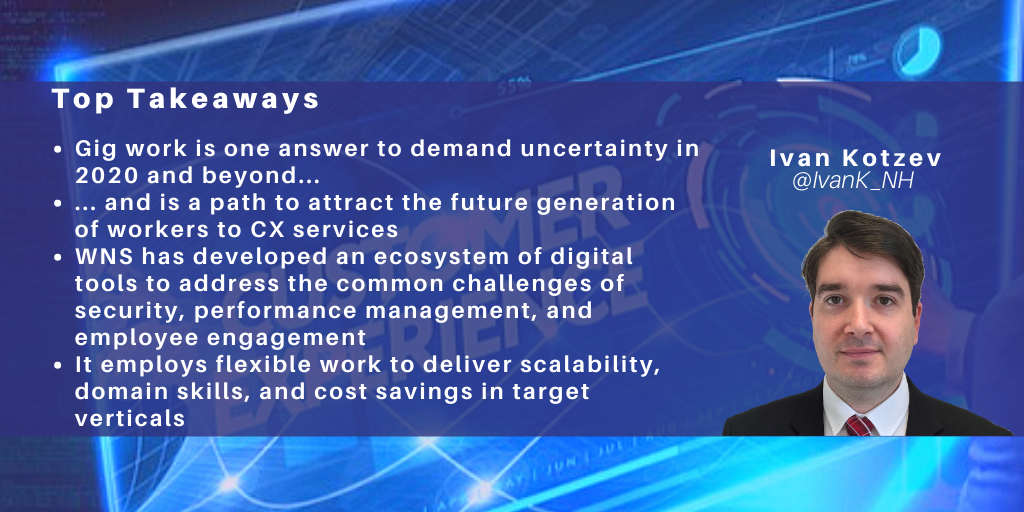Search posts by keywords:
Filter posts by author:
Related Reports
Related NEAT Reports
Other blog posts
posted on Dec 15, 2020 by Ivan Kotzev

In a year when the U.S. stock market pushed to a record high, the U.K. had its worst recession in 300 years, and entire sectors shut down for weeks, business planning has become less reliable while demand fluctuates unexpectedly and inconsistently. The supporting industry of CX services is directly impacted on two fronts:
- Challenges with supply, where the traditional multi-hundred seat production floor cannot operate as usual
- Highly fluid client needs to ramp up and down in shorter time spans while cutting budgets and limiting capital investments.
Gig workers and flexible contractors are steadily becoming an alternative to managing this variability. Starting in early 2020, WNS developed a detailed gig approach, part of its EXPIRIUS CX delivery framework, including IP for digitally-enabled agent life cycle management. EXPIRIUS is WNS’ CX model integrating human-assisted design and domain expertise with AI-driven conversational insights and consulting-led CX strategies. Its gig operating approach includes workforce optimization to predict volumes for flexible hiring.
Workforce Engagement for Gig Work
The gig model offers workers the ability to work when they can or want, operate as independent contractors for part-time or short-term projects, and work remotely from home for most programs. The three biggest challenges are security and data protection, performance management on remote workstations, and distributed employee engagement. WNS tackles each of these issues with a set of proprietary and third-party instruments:
- Security, with two factor authentication, biometric verification with facial confirmation, system and desktop monitoring, video observation, analytics for violation detection, and other tracking features. The company uses a third-party employee monitoring tool, customizing the system to match the BPS requirements. For example, it trained the image recognition facility to distinguish electronic devices from other objects in the webcam’s viewing angle and enabled features such as imposter detection
- Performance management, with a proprietary real-time back-office floor management tool which tracks agent activity on productive and non-productive applications. It has already deployed the tool across ~3k employees. Another WNS tool is a team collaboration platform. Further, the company has changed its performance management practice to include quicker and more frequent reviews, and uses NICE for QA
- Engagement, where WNS enabled digital agent recruitment with an enterprise recruitment system (SmartRecruiters), remote onboarding (ClickBoarding), and virtual training classrooms. The company has its own AI-based digital learning and knowledge platform, GLINT, with micro-learning modules, analytics, and gamification.
To enhance its distributed workforce engagement, WNS created a mobile app, hYve, with an engagement bot. The bot answers employees’ HR and training questions, allows escalation of concerns anonymously, and runs ESAT surveys. It proactively asks the employee about motivation, health, support from team leaders, and knowledge resources.
Benefits of Gig Work
Its scalability is particularly useful for highly seasonal demand in sectors such as retail and travel. The WAH element and flexibility also expand the addressable talent pool in terms of geographies such as tier 3 cities in India, demographics such as pensioners, and niche skillsets across domains. For example, for a North American full-service airline with a typical volume peak in the last three months of the year, WNS designed a workforce model for IRROPS and baggage queries. It recruited part-time and temporary staff with a minimum daily login of 4.5 hours, onboarded and trained them in two weeks, and scaled the existing ~70 FTEs to a ~130 member team during the short peak season.
Before the gig model, one of the difficulties of effectively substituting full-time experienced agents was the complexity of interactions and required skillsets. WNS deals with this challenge by decoupling processes to individual tasks or by separating workflows at the customer end to streamline the overall handling. An example is a U.K. catalog retailer for which COVID-19 impacts increased inbound sales call volumes dramatically, resulting in ~20k calls lost per day. It needed skilled resources to handle sales orders. WNS redesigned the client IVR tree to create a separate route for new order calls and staffed it with an hourly workforce who handled the surge volumes and improved the order management and dispatch.
Finally, from WNS’ experience with gig work, the typical reduction in cost-to-serve is between 10-20% compared to permanent, full-time workers. An example is a U.K. utility company which has a quarter of its weekly calls on Monday alone, with intraday peaks over four hours. WNS supports the account from South Africa. During the COVID-19 pandemic, limited employees are allowed in the office, so WNS developed WAH operations with onboarding, training, and nesting for ~300 full-time and gig agents. The significant savings come from both balancing demand with capacity and the reduction of infrastructure costs.
Being Relevant to the Emerging Workforce
Blighted by perennial problems with attrition, and low desirability as a career, the CX services industry faces a new workforce of Gen-Zers who increasingly perceive full-time, 9 to 5 jobs as outdated. The flexible gig model offers one solution, and future-looking providers are actively adopting it.
WNS incorporates the gig model as an essential lever in its EXPIRIUS framework, expecting to reach a quarter of the agent population in the long term. It is already exploring opportunities in Europe to service multilingual programs and plans expansion in India, where the government has recently eased guidelines regarding compliances around WAH for the IT/BPM sector. The company is particularly bullish on the back of its current implementations and scalable digital infrastructure, its pipeline of client demand for BCP, responding to clients’ business variability, and the advantages of its domain focus in a few key verticals. It is now investing in consistent agent experience and knowledge by building an SME bot to integrate with its learning platform.
